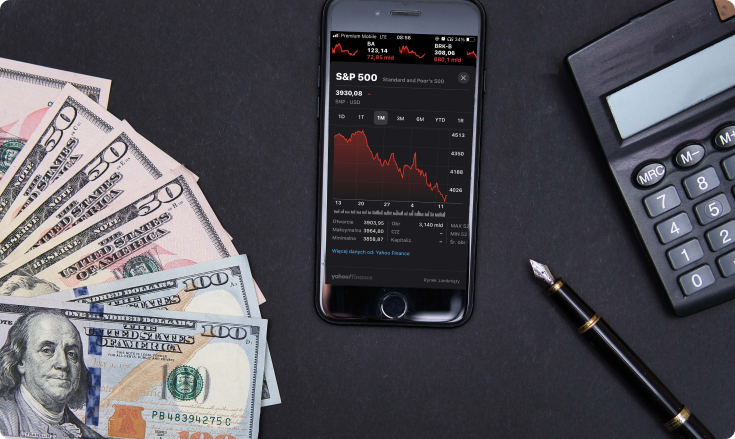Take-Profit Order Explained

As any risk disclosure will tell you, trading financial instruments put the trader at risk of losing some or all of their allocated capital. Regardless if one is involved in stocks, cryptocurrency, indices, or forex trading, this is an unquestionable fact. That's why clever traders implement strategies that include concrete risk management parameters.
A key aspect of managing risk is clearly defining when to exit an open position. In the live market, positions have two potential results, which are profit and loss. For those who meet their financial goals, risk and reward are aligned, ensuring that long-term gains outweigh losses. To accomplish this objective, various order types are used including the stop loss and take-profit.
Before even opening a position, you, as a trader, should learn about a take-profit order.
Together with a stop-loss order, a take-profit order is the most common and the most helpful order that a trader can set. This command helps you maximize your profit by predefining a point that will once reached, automatically trigger a sale. It is very easy to understand and apply.
What is a take-profit order?
Take-profit order belongs to a group of limit orders, which is an order to buy or sell a stock at a specific price or better. A buy limit order can only be executed at the limit price or lower, and a sell limit order can only be executed at the limit price or higher. However, a limit order is not guaranteed to execute. This is an order type that does not open a trade immediately. Instead, it tells a broker to open a trade when the price reaches a certain level.
Take-profit order goes one step more in comparison to limit order. It specifies a certain price above the purchase price, which is chosen by the trader. If the price of an asset reaches that limit, it will automatically trigger a sale. In other words, the order will close a position when the price reaches a certain level, and the trader will take profit. If the price does not reach the preset limit, the order will not be not acted on. While with a stop-loss order the position is closed for a loss, in take-profit it is closed for a gain. Take profit is abbreviated as (T/P).
In simple words, a take profit defines the exit order of a positive open position. It is the market price at which a winning trade is closed and financial gain is realized. Once the take-profit point is reached on a certain position that a trader holds, the order is triggered, and the sale goes through at that day's current market value. If that point isn't reached, the sale is not executed, and the trader holds on to the asset.
When to use a take-profit order?
A take-profit order is a short-term trading strategy. Take-profit orders are beneficial for short-term traders interested in profiting from a quick bump in asset costs. It is useful for day traders who want to take advantage of a quick rise in the cost of assets to make an immediate profit. You can get out of the market as soon as you hit your profit target, without letting your gains slip away in a later downturn. Take-profit can also pay off when you’re trading against the trend, as prevailing trends tend to continue over time.
Investors use this order in a bullish environment. This means that investors set a stop price when they believe that prices might go up. In that case, they set a take-profit order to maximize their potential gains on a certain level.
When you are leaving for holidays or trading in a highly volatile market that could change direction overnight, you would be advised by every mindful brokerage or investor to set a take-profit order. However, we recommend you to place both a take-profit and a stop-loss order every time you feel that it would reduce your trading risks.
Advantages & disadvantages of a take-profit order
When we talk about the advantages and disadvantages of a take-profit order, we can say that the benefits are greater than the disadvantages. Take a look below.
Advantages:
- Ensures a profit. It is set to ensure that a day trader makes some level of profit. If your order is successful, you’re guaranteed to make money on the trade.
- Minimizes risk. It allows you to use a quick rise in the market, rather than potentially missing the chance of selling it at a profit point. By exiting the trade as soon as it hits the target price, you can take advantage of quick rises while limiting your exposure to the market.
- Avoids overthinking. Because the trade happens automatically, you don’t have to make a hurried decision of selling or buying in an instant. This means there is no risk of questioning decisions over and over.
Disadvantages:
- Not suitable for long-term traders. This order is more suitable for short-term traders because they guarantee you make a certain level of profit quickly. They are not that good for long-term traders, who are investing and trading in the long run and are willing to tolerate more ups and downs in the market in order to potentially make a larger profit in the end.
- Missing out on a rising trend. When there is a rising trend taking place, it can last for a longer period, and by setting the take-profit order you can’t take advantage of this trend. A trader can get frustrated once they realize that there was a good ongoing trend, while they exited the position too early, due to the set order.
- Might not be executed at all. There is no guarantee that with a take-profit order in place, a sale will happen. In case the market never rises to the take-profit level you set, a trader might have to sell at a loss.
Example
This is a type of standing order that is placed to close a profitable position once the market reaches a specific price. As the name suggests, it allows the trader to set a predefined level to lock in any profits. In other words, it takes the profit as it closes the position. For example, a trader goes long (in other words, enters a buy position) by entering the market at 1.2981, expecting prices to rally higher. He wants to benefit from the rise, so he places a take-profit order at a level higher than the entry price, say 1.3185. If the bid price hits the predefined take profit price at 1.3185, the position is closed and profits are locked in.
Similarly, if a trader goes short (enters a sell position), expecting prices to fall, he places a take-profit order at a lower level than the entry price because he wants to benefit from the fall. Let’s say this trader entered the market at the same price, 1.2981. In this case, he decides to place his take-profit at 1.2882. If the ask price hits that predefined take-profit price, the position is closed and any profit is locked in.

How to set a take-profit on MetaTrader5?
Here are the instructions on how to set a take-profit order for Mobile Android:
- First tap on the Charts tab at the bottom of the screen;
- Then select the crosshair tool from the toolbar at the top. Tap and drag the crosshair around to get the prices for your stop loss, entry pending order, and take profit;
- Then tap the square with the “+” symbol in the upper right corner. This will open the order entry system;
- Choose your order type and lot size (middle number) at the top of the screen.
- Next, tap on the Take Profit box and enter the prices you wrote down in the crosshair step.
You can adjust or cancel a Take Profit while your Forex trade is open and you’re monitoring the market. You can also add a Take Profit to a forex position that’s already open.
Conclusion
Most traders use take-profit orders in conjunction with a stop-loss order to manage their open positions. If the security rises to the take-profit point, the T/P order is executed and the position is closed for gain. If the security falls to the stop-loss point, the S/L order is executed and the position is closed for a loss.
Active trading may be a profitable activity when conducted within the context of a viable trading plan. Also, a key part of any such plan is exiting the market efficiently at a gain or a loss. The take-profit order, stop loss order, and risk vs reward ratio are key elements in establishing a consistent trading plan.
The strategic importance of take-profit orders can't be understated. Traders are advised to quantify the type of take-profit, as well as the location, before opening a new long or short position in any market. Although past performance is not indicative of future results, regular application of take-profit orders can help establish endurance in the marketplace.
Sources Consulted:
1. Brown, J. What is a Take-Profit Order? https://www.thebalance.com/what-is-a-take-profit-order-1344975 (2022)
2. Chen, J. Take-Profit Order. https://www.investopedia.com/terms/t/take-profitorder.asp (2021)
3. Kimura, H. How To Set a Take-Profit Order on MetaTrade5? https://www.tradingheroes.com/set-stop-loss-take-profit-mt5 (2021)
LimitPrime © 2026
Begin to invest and
start earning today!
Categories
Do you need personalized assistance?
READ MORE INTERESTING ARTICLES

Diversificationnoun the action of diversifying something or the fact of becoming more diverse. a trading strategy that reduces risk. D...
Read More
What are indices?Indices measure the performance of a group of stocks, bonds or other investments. These investments are often grouped...
Read More
Electronic currency is non-tangible money that exists in your bank account and can be used for various payments. In essence, it’s an el...
Read More